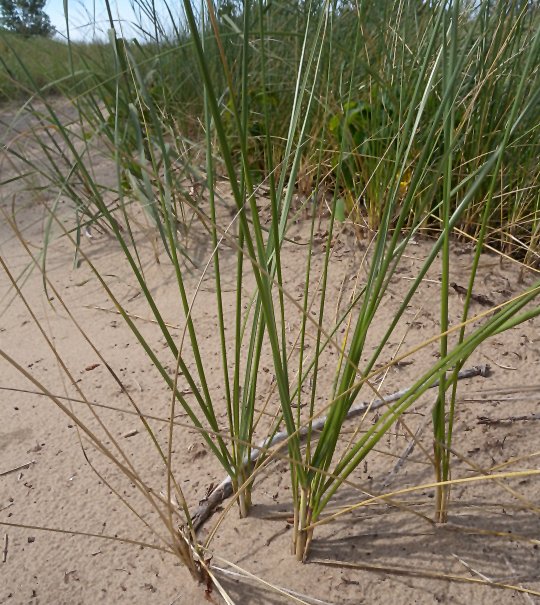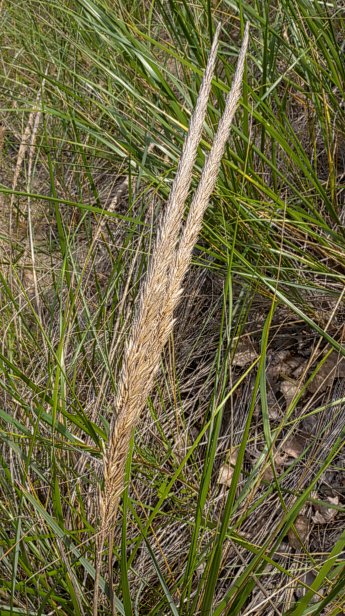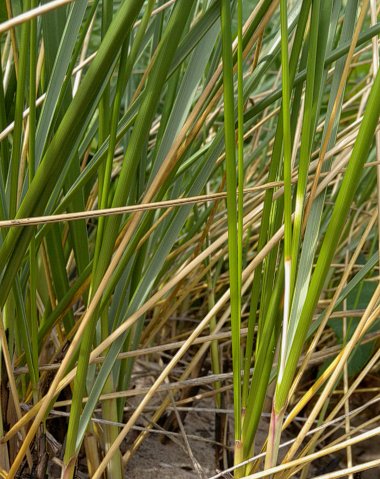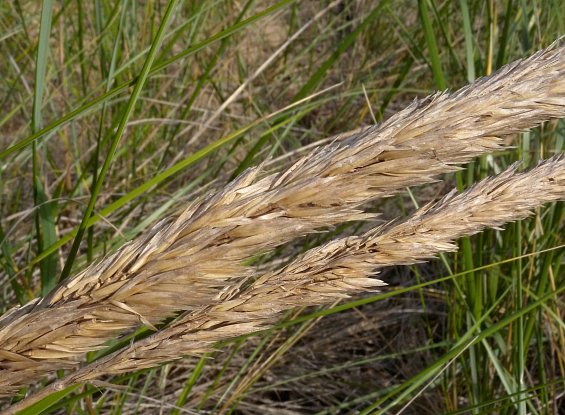
Occasionally, a culm terminates in a spike-like panicle about 6-14" long and less than ¾" across. Each panicle has a central stalk (rachis) and several lateral branches up to 2" long that are erect. Several single-flowered spikelets on short pedicels occur along each lateral branch of the panicle. Individual spikelets are 9-15 mm. long and slightly flattened, consisting of a pair of glumes, a lemma, a membranous palea, and a single floret. The glumes are 9-15 mm. long, linear-lanceolate in shape and keeled along their outer surfaces. The lemma is a little shorter than the glumes and linear-oblong in shape; there is a small tuft of hairs at its base. The floret consists of an ovary, 3 stamens, and a pair of stigmata. The blooming period can occur from late spring to late summer. The florets are wind-pollinated. Afterwards, fertile lemmas are replaced by elongated grains about 3.0-3.5 mm. in length. The root system is fibrous and long-rhizomatous. Reproduction occurs primarily by the rhizomes, which can form large colonies of plants.

Cultivation: The preference is full sun, mesic to dry conditions, and very sandy soil. Propagation occurs primarily by dividing clumps of plants and their rhizomes, as most seeds are not viable. This grass can withstand burial by sand up to 1' in depth. The root system is dependent on the presence of mycorrhizal fungi to extract nutrients from the very sandy soil where this grass occurs. Away from beaches and neighboring sand dunes, this grass succumbs to damage from nematodes, making its establishment more difficult, if not impossible.
Range & Habitat: The native Beach Grass is rare in Illinois and state-listed as 'endangered.' It is found only in the NE section of the state along Lake Michigan (see Distribution Map). In the United States, this grass occurs along beaches of the Great Lakes and the Atlantic coast. Habitats are restricted to drier areas of sandy beaches and unstable or partially stable sand dunes along Lake Michigan and the other Great Lakes. This grass also occurs along the Atlantic coast of northeastern United States. It plays an important role in stabilizing sand in these habitats and preventing blowouts. Eventually, as organic matter builds up, this sets the stage for the colonization of other species of plants. In addition to destruction of habitat by urban development, Beach Grass is vulnerable to trampling by pedestrians and the use of off-road vehicles. Where the latter problems exist, it can be protected by erecting fences around colonies of plants.

Faunal Associations: The following information has been derived from published material about Beach Grass populations along both the Atlantic coast and Great Lakes. Some faunal species may not occur in both areas. The following insects have been observed to feed on Beach Grass: Eriococcus carolinae (Beach Grass Scale), which sucks sap from the stems and leaves; larvae of the gall midge Mayetiola ammophilae, which feed within the stem bases, causing them to rot; Strigoderma arboricola (False Japanese Beetle), which feeds on the florets and developing seeds; a June Beetle, Phyllophaga rugosa; larvae of the Gelechiid moth, Chionodes arenella; and Trimerotropis verruculata (Crackling Forest Grasshopper), which sometimes feeds on the leaves. The root system of Beach Grass is attacked by Meloidogyne sasseri (Beach Grass Root-Knot Nematode) and other nematodes. Birds and other vertebrate animals use Beach Grass primarily for cover and nesting habitat; examples include the Short-Eared Owl, Piping Plover, Vesper Sparrow, and various gulls. The Snow Bunting and probably other granivorous birds eat the seeds to a minor extent. For more information about floral-faunal relationships for this grass, see Eastman (2003) and Maun (2009).

Photographic Location: A large sand dune along Lake Michigan at the Indiana Dunes State Park in NW Indiana.
Comments: Although its population has declined, particularly in Cook County, this is the dominant grass of beaches and sand dunes along southern Lake Michigan. The stiff ascending leaves provide Beach Grass with a unique appearance, making it easy to identify. The large inflorescence is also rather showy. Another species in this genus, the non-native Ammophila arenaria (European Beach Grass), differs by having much longer ligules. This latter species is not found in Illinois, although it has been introduced successfully along the Pacific coast in northwestern United States.